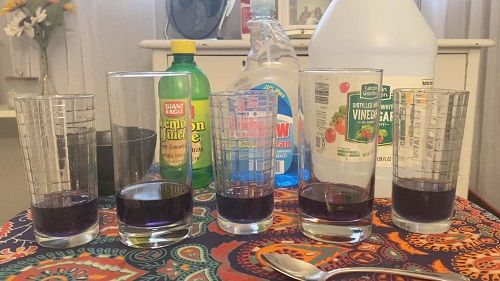Purple Cabbage at Home Experiment
Let's learn about acids and bases by conducting the Purple Cabbage experiment.
Connected Standard
3.2 1.A.6 Participate in simple investigations of matter to answer a question or to test a prediction.
What You Will Need
- Small Red Cabbage
- Large Pot
- Water
- 5 Clear Cups or Glasses
- Baking Soda
- Lemon Juice
- Windex
- Vinegar
- Spoon
Instructions
Preparation
- Prepare the purple cabbage solution by bringing a large pot of water to a boil (fill the pot about 3/4 of the way).
- After the water is boiling, add the leaves of the red cabbage to the water until the cabbage is gone.
- Let boil for 5 minutes.
- Remove from heat and let sit for about 30 minutes.
- Strain to separate the cabbage juice from the leaves.
- Refrigerate cabbage juice until you are ready to use it.
Experiment
- Gather the baking soda, lemon juice, Windex, and vinegar.
- Put a small amount of cabbage juice into 5 clear glasses or cups (about 1/4 cup works well, but you can scale up or down).
- Add about a tablespoon of baking soda to the first class. Continue the same process for the lemon juice, Windex, and vinegar and observe what happens! Make sure you leave the 5th glass alone (this will be the control).
- Observe what happens as you add the different products to your glasses. Compare them to the 5th glass that did not have anything added to it.
The Science Behind It
This experiment is used to test for different types of molecules called acids and bases. The cabbage juice turns a greenish blue color when it meets a base and reddish color when it meets an acid! This means our baking soda and Windex are bases and our vinegar and lemon juice are acids!
Books to Pair with This Experiment
- Ada Twist, Scientist by Andrea Beaty
- Acids and Bases - Food Chemistry for Kids by Baby Professor
Handout
Download the Purple Cabbage PDF to print or save.

